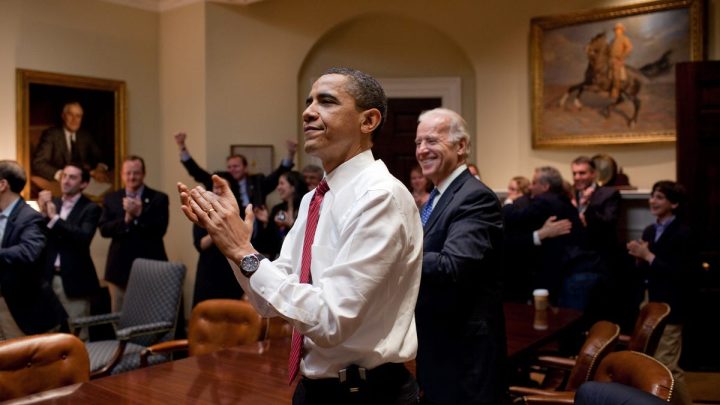
What is “home” in the American imagination? Politicians often cite this ideal. Will our “doors” be open or closed? What do our “neighbors” look like? In the introduction to The Age of Surveillance Capitalism, Shoshana Zuboff describes the home as “where we know and where we are known, where we love and are loved. Home is mastery, voice, relationship, and sanctuary: part freedom, part flourishing … part refuge, part prospect.” Barack Obama promised this image of home, preaching that the United States could pursue unity and love for all. His very presence as a Black man on the world stage signaled a cultural shift that made it seem, if only briefly, that a tide was turning and the US was ready to grapple with its racism. For many, he was a symbol of progress. To others, he was a conniving invader, a covert socialist/communist/terrorist, or even the antichrist. Both images leave his actual humanity behind. What happens when a person becomes a symbol?
The new HBO film Obama: In Pursuit of a More Perfect Union looks at his life and work with a level of nuance that’s rare for a mainstream documentary. Still, like most Obama movies, the focus remains firmly on his social and cultural impact rather than his policy. “People underestimate the value of symbols,” Ta-Nehisi Coates argues at one point. Undeniably, Obama himself catered to and was well aware of his symbolic importance. And most films about him, made by a sympathetic media — By the People, The Final Year, The Way I See It, etc. — cater to his image as a historic groundbreaker. Even the Michelle Obama biography Becoming portrays the former first family as beacons of hope in a dark time.
In Pursuit of a More Perfect Union at least breaks the mold by featuring some critical voices as it examines the compromises Obama made to win and then keep the presidency — sometimes to the point of sacrificing his friendships and values. This is significant since the films in the Obama documentary subgenre are often hesitant at best to address his failures or more malicious policies. They ignore how he bailed out Wall Street, continued US imperialism as usual, and eventually all but forsook any real change in favor of Clinton-style neoliberalism. Even as these issues became harder to ignore in reality, these movies have stubbornly tried to keep alive the image of the 2008 Obama. Concrete references to his actual presidency tend to stick to the highlights, such as the advent of marriage equality or the passage of the Affordable Care Act.
One factor making it difficult to criticize Obama in good faith is the right-wing counterculture that emerged against him. Overnight an entire grifter industry of books, movies, social media influencers, and phony activists sprung up to cater to reactionaries. Filmmakers (to use the term loosely) like Dinesh D’Souza found career resurgences in appeasing to white conservatives, telling them Obama and the Democratic Party were trying to instate a dictatorship — often rewriting history in the process. The mirror of Obama as a symbolic liberal savior was Obama as the harbinger of the decline of the “white race.” Between these polarized views, what he symbolized often overshadowed any individual policy, action, or value.
This new film takes its title from Obama’s landmark “A More Perfect Union” speech from March 2008. In it, he addressed controversial remarks by Jeremiah Wright, his former pastor and until several days prior a worker on his campaign. Obama both acknowledged the history of white supremacy in the US and validated Black anger against it, but then argued against Wright’s conclusions on the matter. He asserted that it was time to move beyond division and work toward change. He said Wright was wrong because “he spoke as if our society was static, as if no progress has been made.” The speech was widely praised, but to some of his critics (such as Cornel West, one talking head here), it presented a false equivalence between Black anger and white resentment, and stands as an example of how Obama tailors his rhetoric and politics to appease white people.
Throughout the documentary, we hear a similar refrain from friends and colleagues. While many of them understand why he made the choices he did, there’s a sense of disappointment that his pleas for unity fell on deaf ears. He softened his stances on (or outright turned his back to) fundamental struggles against racism and poverty, and for what? The vicious backlash mobilized against him led to the Tea Party and eventually the political rise of Donald Trump.

In treating Obama’s legacy with kid gloves, liberal documentaries evince an unwillingness to be critical of the American experiment itself. His failures as president expose the fundamental brokenness of the society around him. If Barack Obama truly represents the US at its best, then that demonstrates how fragile and static the country truly is. Eight years were never going to be enough. It’s no longer easy to pretend that some imaginary path toward national progress and unity would have continued onward, even if history had taken a different turn (i.e. the election of Clinton rather than Trump in 2016).
Perhaps more than anything, Obama’s legacy was poisoned by the four years that followed him. Many of his genuinely progressive victories were quickly dismantled or threatened (and remain so). Meanwhile his worst tendencies, like the expansion of the surveillance state and callous mass deportations, were all intensified. The stark contrast between Obama and Trump made many in positions of privilege finally take notice of the US’s deep-seated issues, as the pleas for unity were replaced with divisive rhetoric. By the last year of Trump’s term, as an incompetently managed pandemic forced millions to stay inside, the home itself was exposed as inhospitable and insecure. So what does the home look like in the American imagination now, and what hope is there that its promise will ever be fulfilled?
0 Commentaires